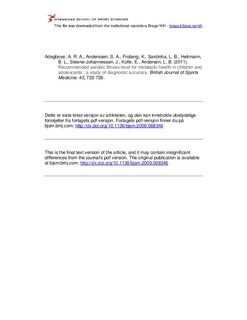| dc.contributor.author | Adegboye, Amanda R. A. | |
| dc.contributor.author | Anderssen, Sigmund A. | |
| dc.contributor.author | Froberg, Karsten | |
| dc.contributor.author | Sardinha, Luis B. | |
| dc.contributor.author | Heitmann, Berit L. | |
| dc.contributor.author | Steene-Johannessen, Jostein | |
| dc.contributor.author | Kolle, Elin | |
| dc.contributor.author | Andersen, Lars Bo | |
| dc.date.accessioned | 2012-01-30T07:34:26Z | |
| dc.date.available | 2012-01-30T07:34:26Z | |
| dc.date.issued | 2010 | |
| dc.identifier | Seksjon for idrettsmedisinske fag / Department of Sports Medicine | |
| dc.identifier.citation | British Journal of Sports Medicine. 2011, 45, 722-728 | no_NO |
| dc.identifier.issn | 1473-0480 | |
| dc.identifier.issn | 0306-3674 | |
| dc.identifier.uri | http://hdl.handle.net/11250/170779 | |
| dc.description | I Brage finner du siste tekst-versjon av artikkelen, og den kan inneholde ubetydelige forskjeller fra forlagets pdf-versjon. Forlagets pdf-versjon finner du på www.bjsm.bmj.com: http://dx.doi.org/10.1136/bjsm.2009.068346 / In Brage you'll find the final text version of the article, and it may contain insignificant differences from the journal's pdf version. The original publication is available at www.bjsm.bmj.com: http://dx.doi.org/10.1136/bjsm.2009.068346 | no_NO |
| dc.description.abstract | Objective To define the optimal cut-off for low aerobic fitness and to evaluate its accuracy to predict clustering of risk factors for cardiovascular disease in children and adolescents.
Design Study of diagnostic accuracy using a cross-sectional database.
Setting European Youth Heart Study including Denmark, Portugal, Estonia and Norway.
Participants 4500 schoolchildren aged 9 or 15 years.
Main Outcome Measure Aerobic fitness was expressed as peak oxygen consumption relative to bodyweight (mlO2/min/kg).
Results Risk factors included in the composite risk score (mean of z-scores) were systolic blood pressure, triglyceride, total cholesterol/HDL-cholesterol ratio, insulin resistance and sum of four skinfolds. 14.5% of the sample, with a risk score above one SD, were defined as being at risk. Receiver operating characteristic analysis was used to define the optimal cut-off for sex and age-specific distribution. In girls, the optimal cut-offs for identifying individuals at risk were: 37.4 mlO2/min/kg (9-year-old) and 33.0 mlO2/min/kg (15-year-old). In boys, the optimal cut-offs were 43.6 mlO2/min/kg (9-year-old) and 46.0 mlO2/min/kg (15-year-old). Specificity (range 79.3–86.4%) was markedly higher than sensitivity (range 29.7–55.6%) for all cut-offs. Positive predictive values ranged from 19% to 41% and negative predictive values ranged from 88% to 90%. The diagnostic accuracy for identifying children at risk, measured by the area under the curve (AUC), was significantly higher than what would be expected by chance (AUC >0.5) for all cut-offs.
Conclusions Aerobic fitness is easy to measure, and is an accurate tool for screening children with clustering of cardiovascular risk factors. Promoting physical activity in children with aerobic fitness level lower than the suggested cut-points might improve their health. | no_NO |
| dc.language.iso | eng | no_NO |
| dc.publisher | BMJ | no_NO |
| dc.subject | adolescents | no_NO |
| dc.subject | blood pressure | no_NO |
| dc.subject | body weight | no_NO |
| dc.subject | physiology | no_NO |
| dc.subject | cardiovascular diseases | no_NO |
| dc.subject | metabolism | no_NO |
| dc.subject | child | no_NO |
| dc.subject | cholesterol | no_NO |
| dc.subject | cross-sectional studies | no_NO |
| dc.subject | Europe | no_NO |
| dc.subject | exercise physiology | no_NO |
| dc.subject | female | no_NO |
| dc.subject | health status | no_NO |
| dc.subject | humans | no_NO |
| dc.subject | insulin resistance | no_NO |
| dc.subject | male | no_NO |
| dc.subject | oxygen consumption | no_NO |
| dc.subject | physical fitness | no_NO |
| dc.subject | ROC curve | no_NO |
| dc.subject | risk assessment | no_NO |
| dc.subject | risk factors | no_NO |
| dc.subject | sensitivity and specificity | no_NO |
| dc.subject | skinfold thickness | no_NO |
| dc.subject | triglycerides | no_NO |
| dc.title | Recommended aerobic fitness level for metabolic health in children and adolescents: a study of diagnostic accuracy | no_NO |
| dc.type | Journal article | no_NO |
| dc.type | Peer reviewed | no_NO |
| dc.subject.nsi | VDP::Social science: 200::Social science in sports: 330::Other subjects within physical education: 339 | no_NO |
| dc.source.pagenumber | 722-728 | no_NO |
| dc.source.volume | 45 | no_NO |
| dc.source.journal | British Journal of Sports Medicine | no_NO |
| dc.source.issue | 9 | no_NO |
